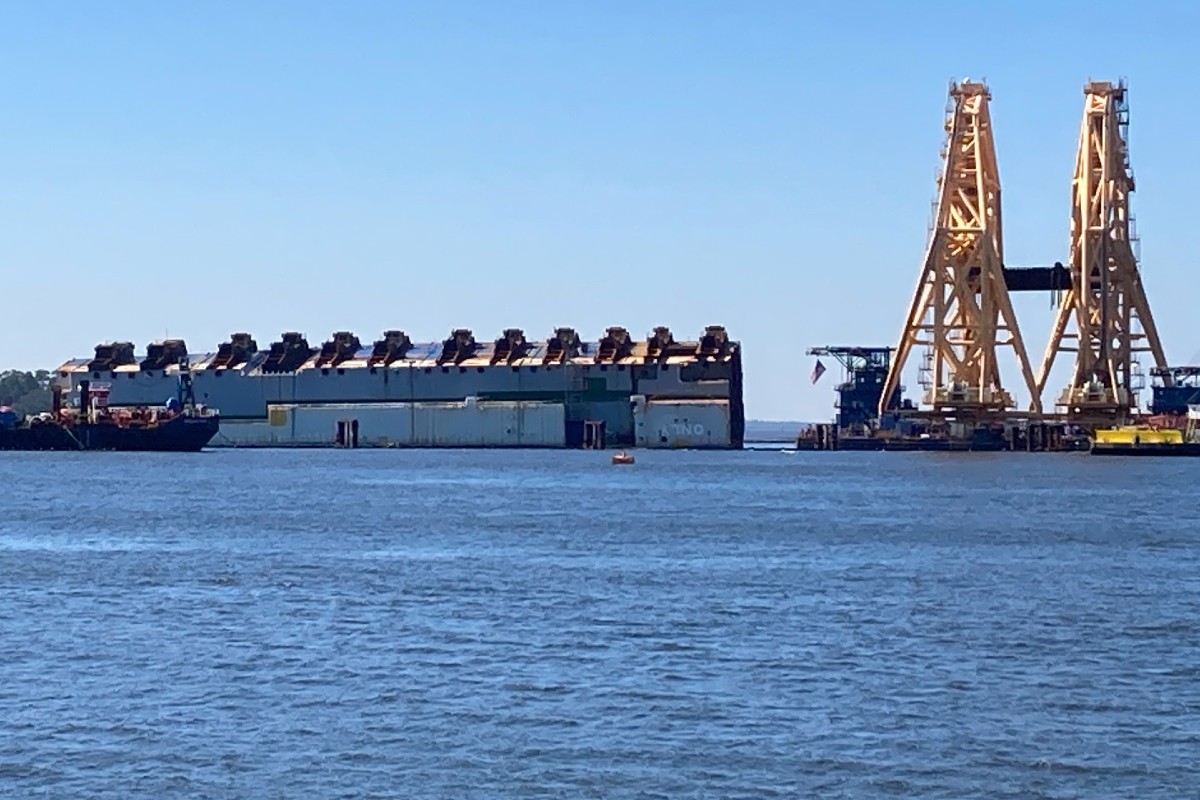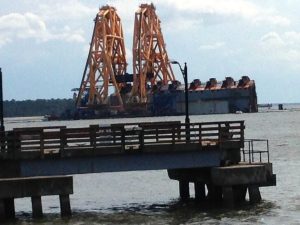By Elliott Brack
Editor and Publisher, GwinnettForum
MAY 14, 2021 | The continuing story coming out of the Golden Isles of Georgia is what’s taking place between St. Simons and Jekyll Island…..something being called the “Saga of the Golden Ray.” That’s the title of an informative article by Cathy Coleman in the spring issue of the local magazine, High Tide. We visited the Golden Isles last week and were mesmerized by the salvaging attempts.
![]() All this started on Sept. 8, 2019 when the auto carrier Golden Ray was departing the Georgia Ports Authority Brunswick vehicle terminal, headed back to sea, after 360 SUVs were driven on board, altogether hauling 4,200 vehicles. (Its capacity is 8,400 vehicles.)
All this started on Sept. 8, 2019 when the auto carrier Golden Ray was departing the Georgia Ports Authority Brunswick vehicle terminal, headed back to sea, after 360 SUVs were driven on board, altogether hauling 4,200 vehicles. (Its capacity is 8,400 vehicles.)
As Harbor Pilot Jonathan Tennant guided the ship under the Sidney Lanier bridge, and made a right turn into the sound between the two islands, something happened. The ship was oversteering to starboard. When he sought a correction, the ship was unresponsive. He radioed an incoming ship, saying ‘I’m losing her.” Almost immediately, the ship capsized.
As Coleman reports: “Amazingly, he (the pilot) was able to ground the ship on the sandbar just outside the (32 foot wide) shipping channel.” The pilot’s coolness and his grounding on the sandbar, instead of in the channel, earned him respect as a hero.
The pilot and 19 of the crew of 23 on the ship were soon rescued by the Coast Guard. Another four men trapped in the ship were eventually safe. No lives were lost.
The grounding happened 20 months ago, and still salvagers are trying to remove the ship from the sound. Meanwhile, after a few days delay, ships could still navigate through the shipping channel to offload cargo.
Salvaging the ship’s cargo and attempts to remove the ship from the channel have been slow. It also is expensive, $800 million at last reports, all paid by Korean shipping and insurance firms.
First some 6,000 tons of rock from Georgia quarries came to the site via trucks and barges, to surround the ship to slow tidal erosion of the sandy bottom. Another early step: removing 320,000 gallons of fuel mixed with sea water. Meanwhile, environmentalists daily check the nearby island beaches for damage, but have reported little so far.
Eventually, the mammoth Versabar 10,000 twin gantry catamaran, some 255 feet tall, with two massive yellow towers, came to the site to envelop the downed ship. It’s the largest lift vessel ever built in the states. It’s so big that even the largest cruise ships take up only half the vertical spacing. The crane’s winches and pulleys have been slowly sawing the ship’s hull into giant pieces, to float on barges to the Brunswick port, and eventually to Louisiana for scraping. The first section was the 3,100 metric ton bow, which took three weeks to saw. Other sections have taken longer. So far four of the seven sections have been moved to port.
The automobiles on the ship’s 13 decks when the ship rolled over, were then in vertical shafts, and fell to the bottom, damaged and stacked on one another. In port, giant derricks reach into the sections of the ship to snare car-by-car to load onto barges for scrap. This reduces the weight of the ship’s sections, making it easier and lighter to ship for scraping.
A good vantage point to watch the salvaging is from the St. Simons pier. The ship is about a mile and half away. But it is not a fast-moving operation, with little action, but only slow progress. It’s the talk of the islands, with salvaging going on for perhaps another one or two months.
- To see videos of this event, go to ssiresponse.com.
- Have a comment? Send to: elliott@brack.net












Follow Us